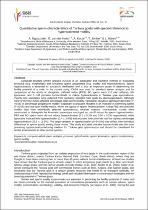Quantitative sperm characteristics of Tankwa goats with special reference to hyperactivated motility
Abstract
Computer-assisted semen analysis (CASA) is an automated and objective method of evaluating
structural (e.g. morphology) and functional sperm parameters (e.g. motility and hyperactivation). Sperm
hyperactivation is essential for successful fertilization and is thus an important aspect in determining the
fertility potential of a male. In the current study, CASA was used for standard semen analysis and for
comparison of the ability of phosphate buffered saline (PBS), BO sperm wash (10 mM caffeine), 4%
lignocaine, and 5 mM procaine hydrochloride to induce hyperactivation in Tankwa goat spermatozoa.
Twenty-nine ejaculates were collected from randomly selected male goats by electroejaculation. Although
none of the four media affected percentage total sperm motility, lignocaine caused a significant decrease (P
>0.05) in percentage progressive motility. Exposure to procaine resulted in an increase in swimming speed
(P ≤0.05) and star-spin motility tracks, which are typical of sperm hyperactivation. Using PBS and procaine
motility data from individually selected spermatozoa, receiver operator characteristic curves were
constructed to distinguish the kinematic parameters employed as cut-off values for sperm hyperactivation.
PBS and BO sperm wash did not induce hyperactivation (0.1 0.2% and 0.04 0.2% respectively), while
lignocaine induced little hyperactivation (3.4 3.0%) and procaine hydrochloride had the highest percentage
hyperactivation (25.3 13.6%). The large variation in hyperactivation (0–54.5%) may reflect inter-individual
differences in sperm quality among these males. This study indicated procaine hydrochloride was the most
promising hyperactivation-inducing medium for Tankwa goat spermatozoa and should be considered for
similar assessments in other animal species.

